6 Places You Must Visit When In Tunisia
By: Priyanka Maheshwari Wed, 21 June 2023 8:10:17
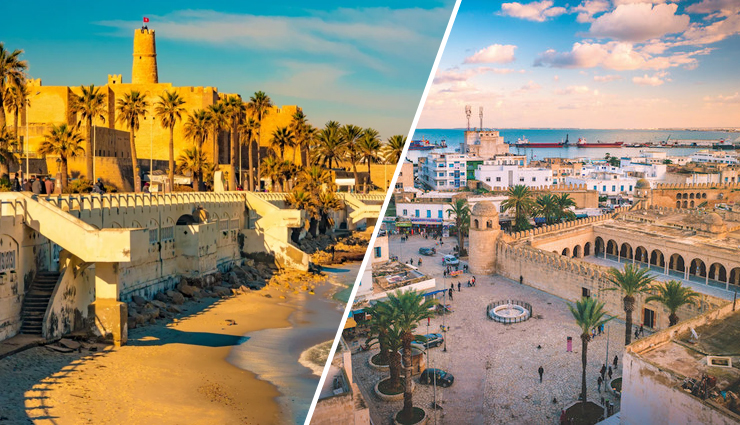
Tunisia is a country located in North Africa on the Mediterranean coast. It is bordered by Algeria to the west and Libya to the southeast. Tunisia is known for its rich history, diverse culture, and stunning landscapes. The capital city is Tunis, and the official language is Arabic, although French is also widely spoken.
Tunisia has a population of around 11 million people and covers an area of approximately 163,610 square kilometers. The country has a varied geography, ranging from fertile coastal plains to the Atlas Mountains in the north and the Sahara Desert in the south.
Tunisia has played a significant role in history, with influences from Phoenicians, Romans, Vandals, Byzantines, Arabs, and the Ottoman Empire. It gained independence from France in 1956 and has since become a republic with a democratic system of government.
The Tunisian economy is diverse, with sectors such as agriculture, manufacturing, tourism, and services contributing to its growth. The country is known for its olive oil production, textile industry, and handicrafts.
Tunisia offers a rich cultural heritage, blending influences from various civilizations. It is home to ancient ruins, including the well-preserved Roman cities of Carthage and Dougga, which are UNESCO World Heritage sites. The medina (old town) of Tunis, with its narrow streets and historic architecture, is also a popular attraction.
In recent years, Tunisia has gained recognition for its role in the Arab Spring, a series of protests and political changes that swept across the region in 2010 and 2011. The revolution in Tunisia led to the ousting of the longtime president and the establishment of a more democratic system.
Tunisia's warm climate, beautiful beaches, and historical sites make it a popular tourist destination. Visitors can explore ancient ruins, enjoy coastal resorts, experience traditional markets, and indulge in delicious Tunisian cuisine, which is a fusion of Mediterranean, Arab, and French influences.
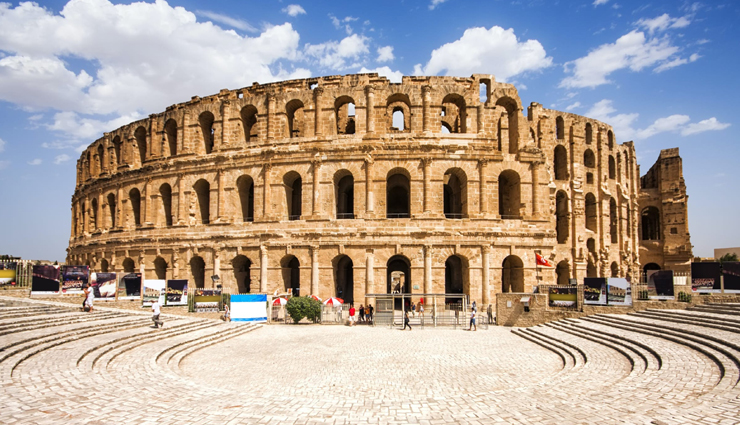
# El Djem Amphitheater
The El Djem Amphitheater, also known as the Colosseum of El Djem, is an impressive ancient Roman amphitheater located in the town of El Djem, Tunisia. It is one of the most well-preserved Roman amphitheaters in the world and is recognized as a UNESCO World Heritage site.
Constructed in the 3rd century AD, during the reign of the Roman Emperor Gordian, the amphitheater was primarily used for gladiator contests and other public spectacles. It had a seating capacity of around 35,000 spectators, making it the third largest amphitheater in the Roman Empire.
The El Djem Amphitheater is renowned for its remarkable architecture and engineering. It is constructed entirely out of stone, using a combination of sand and limestone blocks, and stands as a testament to the advanced building techniques of the Romans. The exterior of the amphitheater features three levels of arches and columns, creating a grand and imposing facade.
The interior of the amphitheater consists of a central arena, where gladiators and other performers would engage in combat and theatrical shows. The seating tiers are divided into different sections, with the lower levels reserved for the wealthy and influential, while the upper levels were for the general public.
One of the most iconic features of the El Djem Amphitheater is its underground labyrinth of tunnels and chambers. This network of passages was used to house animals, slaves, and gladiators before they made their grand entrances into the arena. It also served as a storage area for props and equipment used in the spectacles.
Today, the El Djem Amphitheater is a popular tourist attraction, drawing visitors from around the world. It offers a fascinating glimpse into the grandeur and entertainment of the Roman Empire. Visitors can explore the vast structure, climb to the top for panoramic views, and even walk through the underground passages to get a sense of the amphitheater's operational intricacies.
The El Djem Amphitheater has also gained recognition in popular culture and has been featured in several films, including the famous movie "Gladiator" starring Russell Crowe.
As a remarkable archaeological site, the El Djem Amphitheater stands as a testament to Tunisia's rich historical heritage and serves as a reminder of the country's significant Roman influence.
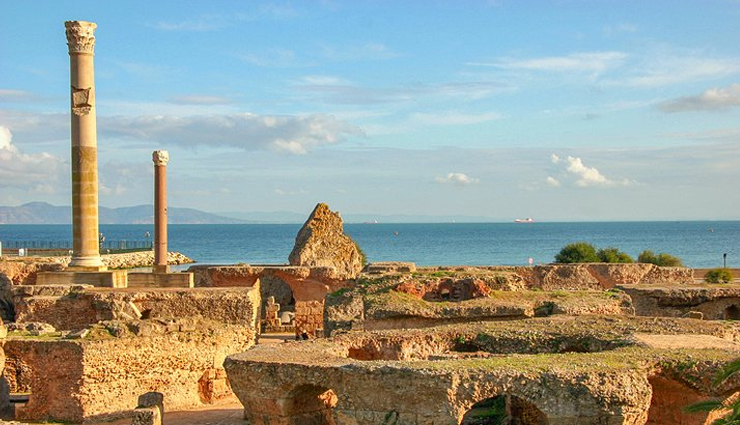
# Carthage
Carthage is an ancient city located on the northeastern coast of Tunisia. It was once a powerful and prosperous city-state in the Mediterranean region and played a significant role in ancient history. Today, it is recognized as a UNESCO World Heritage site and a major tourist attraction.
Carthage was founded by the Phoenicians in the 9th century BC and quickly grew into a dominant maritime and trading power. It became the capital of the Carthaginian Empire, which rivaled the Roman Republic for control of the Mediterranean during the Punic Wars.
The city of Carthage was known for its impressive architecture, advanced engineering, and cultural achievements. It boasted grand palaces, temples, harbors, and an extensive network of fortifications. The most famous structure in Carthage was the Temple of Eshmun, dedicated to the Phoenician god of healing.
Carthage also had a reputation for its skilled navy and seafaring prowess. Its fleet dominated trade routes and played a crucial role in the empire's expansion and influence across the Mediterranean.
The conflict between Rome and Carthage culminated in the three Punic Wars, with Rome ultimately emerging victorious. In 146 BC, after the Third Punic War, the Romans completely destroyed Carthage, leaving only ruins and remnants of the once-great city.
Today, visitors to Carthage can explore the archaeological remains and gain insights into its glorious past. The ruins include the remnants of the ancient city walls, the Roman theater, the Antonine Baths, and the Roman villas with their impressive mosaic floors. The Carthage National Museum also houses a vast collection of artifacts, including sculptures, pottery, and jewelry, offering a glimpse into Carthaginian and Roman history.
The location of Carthage is scenic, situated on a hill overlooking the Gulf of Tunis. It offers breathtaking views of the Mediterranean Sea and the surrounding landscape. Visitors can enjoy strolling through the ruins, visiting the museum, and appreciating the historical significance and architectural splendor of this ancient city.
Carthage is not only a site of historical importance but also holds cultural significance for Tunisia. It represents a connection to the country's Phoenician and Roman heritage, and its preservation and promotion contribute to the understanding and appreciation of Tunisia's rich past.
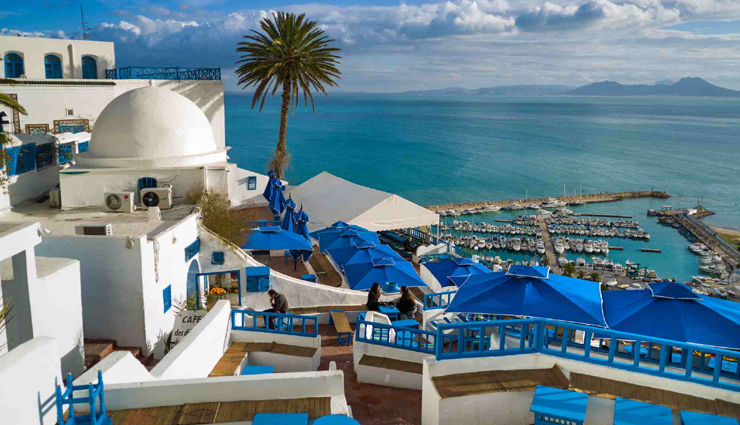
# Sidi Bou Said
Sidi Bou Said is a picturesque village located on a hilltop overlooking the Mediterranean Sea, just a short distance from the capital city of Tunis, Tunisia. Known for its stunning blue and white architecture, charming narrow streets, and panoramic views, Sidi Bou Said is a popular destination for locals and tourists alike.
The village is named after Sidi Bou Said, a revered Muslim saint who lived there in the 13th century. It has become renowned for its distinctive style of architecture, characterized by white-washed buildings with blue doors, window frames, and ornate patterns. This aesthetic gives Sidi Bou Said a unique and enchanting ambiance, often likened to the Greek island of Santorini.
One of the most iconic landmarks in Sidi Bou Said is the Mausoleum of Sidi Bou Said, the final resting place of the saint. The mausoleum is adorned with green tiles and features a peaceful courtyard, attracting both religious visitors and those seeking tranquility.
The main thoroughfare in Sidi Bou Said is Rue Habib Thameur, a pedestrian street lined with shops, cafes, art galleries, and craft stores. Visitors can browse through boutiques selling traditional Tunisian handicrafts, including ceramics, carpets, and textiles. The village is particularly known for its blue and white pottery, with many artisans showcasing their skills.
One of the highlights of a visit to Sidi Bou Said is exploring its narrow winding streets, which are filled with bougainvillea, jasmine, and vibrant flowers. As you wander through the village, you'll discover hidden gems like beautifully adorned doorways, charming cafes with panoramic terraces, and small art galleries showcasing local talent.
The most famous viewpoint in Sidi Bou Said is the Café des Nattes, located at the top of the hill. From its terrace, visitors can enjoy breathtaking vistas of the turquoise waters of the Mediterranean, the white-washed buildings of the village, and even catch a glimpse of the capital city, Tunis. It's a popular spot to relax, sip traditional mint tea, and soak in the stunning surroundings.
Sidi Bou Said has long been an inspiration for artists, writers, and musicians. The village has attracted many renowned figures, including French writer Paul Klee and French singer-songwriter Charles Aznavour. Its timeless beauty and artistic ambiance continue to draw creative souls from around the world.
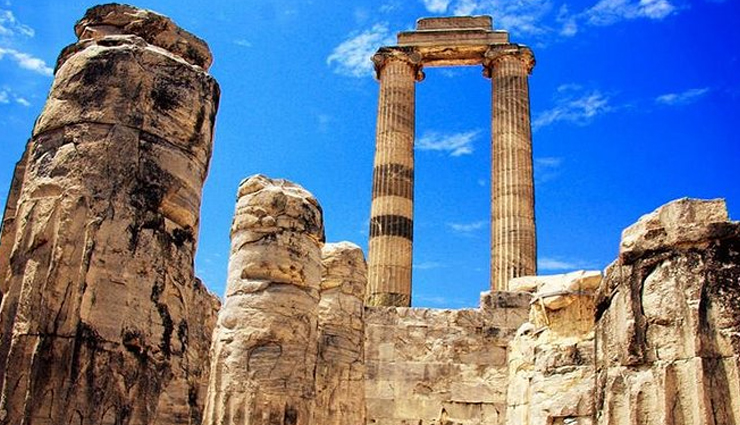
# Bulla Regia
Bulla Regia is an ancient archaeological site located in northwestern Tunisia, approximately 120 kilometers southwest of Tunis. The site was once a thriving Roman city and is known for its unique underground houses, which are among the best-preserved examples of Roman domestic architecture in the world.
Bulla Regia was originally settled by the Berbers, but it grew and prospered under Roman rule during the 2nd and 3rd centuries AD. The city's wealth came from agriculture, particularly the cultivation of olives and cereals, as well as trade along the important Roman road network.
One of the distinctive features of Bulla Regia is its underground villas. Due to the hot climate in the region, the Romans designed these houses with underground levels to provide cooler living spaces during the summer months. The underground sections, known as "hypogea," feature courtyards, living areas, and even intricate mosaics on the floors. These mosaics depict various scenes, including mythological figures, animals, and geometric patterns, showcasing the artistic skill of the time.
The ground-level structures of Bulla Regia are also noteworthy. The city's ruins include the remains of a forum, an amphitheater, temples, public baths, and a triumphal arch. The forum was the center of civic life, while the amphitheater hosted gladiatorial contests and other spectacles. The temples were dedicated to various Roman gods, and the public baths provided a place for socializing and relaxation.
The ruins of Bulla Regia were rediscovered in the 19th century, and extensive excavation and restoration work have taken place to preserve and showcase the site's unique features. Today, visitors can explore the underground houses and other archaeological remains, gaining insight into the daily life and architectural ingenuity of the ancient Romans.
Bulla Regia offers a fascinating glimpse into the past, combining well-preserved underground structures with traditional Roman architectural elements. Its distinctiveness and historical importance have earned it recognition as a UNESCO World Heritage site.
Visiting Bulla Regia allows travelers to step back in time and appreciate the marvels of Roman engineering and aesthetics. The site's underground houses, adorned with intricate mosaics, provide a glimpse into the luxurious lifestyles of the wealthy inhabitants of ancient Bulla Regia. It is a captivating destination for history enthusiasts, archaeology buffs, and anyone interested in exploring the rich heritage of Tunisia.

# Sousse Medina
Sousse Medina is a historic walled city located in the coastal city of Sousse, Tunisia. It is considered one of the best-preserved and most authentic medinas in the country, offering visitors a captivating journey through centuries of history, culture, and vibrant markets.
The medina of Sousse dates back to the 9th century and has been influenced by various civilizations, including the Phoenicians, Romans, Vandals, and Arabs. It served as an important trading hub along the Mediterranean and played a significant role in the region's history.
Entering the medina, visitors are greeted by the imposing Bab el-Ftouh, the main gate that leads into the labyrinthine streets of the old city. The medina's layout is a maze of narrow alleyways, bustling souks (markets), traditional houses, and historic landmarks.
One of the highlights of Sousse Medina is the Great Mosque, also known as the Mosque of Uqba. Built in the 9th century, it is one of the oldest mosques in Tunisia and features stunning architecture and intricate decorations. Non-Muslim visitors can appreciate its beauty from the outside.
Exploring the medina's winding streets, visitors will encounter a variety of traditional crafts and artisan workshops. Skilled craftsmen can be seen working on intricate woodcarvings, ceramics, metalwork, and textiles. The medina is famous for its pottery, and visitors can witness the art of pottery-making and even purchase unique handmade pieces.
Sousse Medina is also known for its vibrant souks, where an array of goods are sold, including spices, traditional clothing, leather goods, jewelry, and souvenirs. It's a vibrant and bustling atmosphere where visitors can immerse themselves in the sights, sounds, and aromas of a traditional North African market.
Within the medina, there are several historic landmarks to explore, such as the Ribat of Sousse. This fortified structure served as a defensive stronghold and a place of spiritual retreat for Islamic warriors. Climbing to the top of the Ribat offers panoramic views of the medina and the surrounding area.
Sousse Medina is a UNESCO World Heritage site, recognized for its outstanding universal value and preservation of its architectural and cultural heritage. The medina's authenticity and traditional way of life provide a captivating glimpse into Tunisia's rich history and cultural heritage.
Visiting Sousse Medina offers a unique and immersive experience, where travelers can get lost in its winding streets, engage with local artisans, haggle in the markets, and soak up the atmosphere of this vibrant and historic city within a city. It is a must-visit destination for those interested in history, architecture, and experiencing the vibrant culture of Tunisia.
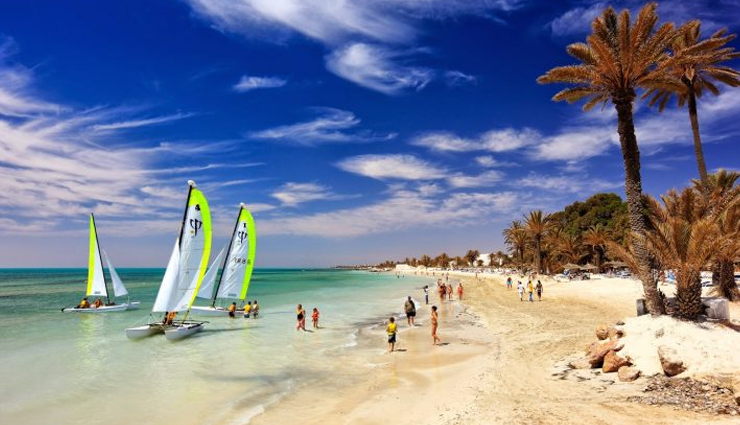
# Djerba Island
Djerba Island, located off the coast of southern Tunisia in the Gulf of Gabès, is a popular tourist destination known for its beautiful beaches, rich history, and unique cultural heritage. It is the largest island in North Africa and offers a diverse range of attractions and experiences for visitors.
The island of Djerba has a rich history that dates back thousands of years. It has been influenced by various civilizations, including the Phoenicians, Romans, Byzantines, Arabs, and Ottomans. The island has served as a strategic trading post and has witnessed the rise and fall of empires throughout history.
One of the most iconic landmarks on Djerba Island is the El Ghriba Synagogue, which is considered one of the oldest synagogues in the world. It is an important pilgrimage site for Jewish visitors and attracts tourists with its beautiful architecture and historical significance.
Djerba is also known for its traditional Berber villages, where visitors can experience the island's unique cultural heritage. The village of Guellala is renowned for its pottery craftsmanship, and visitors can witness artisans creating intricate ceramics using traditional techniques.
The island's coastline is dotted with beautiful sandy beaches, making it a popular destination for sun-seekers and water sports enthusiasts. Many resorts and hotels offer a range of amenities and activities for visitors to enjoy, including swimming, snorkeling, windsurfing, and sailing.
The Houmt Souk, the main town on Djerba, is a vibrant and bustling market where visitors can explore traditional souks, sample local cuisine, and shop for handicrafts, textiles, and spices. The market offers a vibrant and colorful atmosphere, showcasing the island's cultural diversity.
Djerba is also famous for its annual festivals and celebrations. The most notable is the International Festival of Traditional Arts, which takes place in July and attracts performers from around the world, showcasing music, dance, and crafts.
Nature enthusiasts can explore the ecological diversity of Djerba's surroundings. The island is home to salt pans, lagoons, and palm groves, providing opportunities for bird-watching and nature walks. The nearby flamingo island, known as "Ras Rmel," is a sanctuary for migratory birds and offers a unique wildlife experience.
Overall, Djerba Island offers a blend of natural beauty, cultural heritage, and warm hospitality. Its pristine beaches, historical sites, traditional villages, and lively markets make it a captivating destination for travelers seeking a mix of relaxation, exploration, and cultural immersion.





